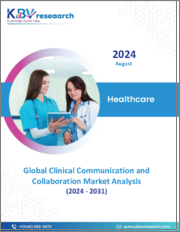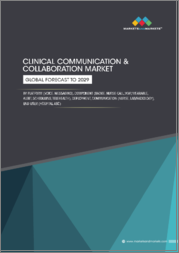
|
시장보고서
상품코드
1587144
세계의 임상 커뮤니케이션 소프트웨어 시장 : 컴포넌트, 전개, 최종 사용자별 예측(2025-2030년)Clinical Communication Software Market by Component (Clinical Alerting & Notification, Physician & Nurse Scheduling Systems), Deployment (On-Cloud, On-Premise), End-User - Global Forecast 2025-2030 |
||||||
임상 커뮤니케이션 소프트웨어 시장의 2023년 시장 규모는 19억 9,000만 달러로, 2024년에는 24억 1,000만 달러에 이를 것으로 예측되며, 복합 연간 성장률(CAGR) 21.20%로 성장하여, 2030년에는 76억 5,000만 달러에 달할 것으로 예상됩니다.
임상 커뮤니케이션 소프트웨어는 병원 및 기타 건강 관리 시설과 같은 임상 환경에서 커뮤니케이션 및 협업 프로세스를 간소화하고 강화하기 위해 설계된 디지털 플랫폼을 의미합니다. 이러한 솔루션은 안전한 메시징, 환자 데이터 공유, 타 스크리닝 관리, 의료 종사자 간의 조정을 촉진하고, 효율적인 환자 케어나 업무 워크플로우에 필수적입니다. 및 정보 전송 지연의 가능성을 크게 줄이는데 두드러집니다.
| 주요 시장 통계 | |
|---|---|
| 기준년(2023) | 19억 9,000만 달러 |
| 예측년(2024) | 24억 1,000만 달러 |
| 예측년(2030) | 76억 5,000만 달러 |
| 복합 연간 성장률(CAGR)(%) | 21.20% |
이러한 소프트웨어의 필요성은 헬스케어 시스템이 복잡해지고 견고한 데이터 취급과 보안 요구가 증가하고 있기 때문입니다. 지속적인 기술이 발전함에 따라 상호 운용성과 환자 중심 치료를 강화하기 위해 이러한 도구를 전자 의료 기록(EHR)과 통합하는 움직임이 커지고 있습니다. 이러한 솔루션의 주요 최종 사용자는 병원, 클리닉 및 간호 시설에서 업무 효율성과 환자 결과 개선에서 이익을 얻고 있습니다.
이 시장을 견인하는 주요 성장 요인으로는 디지털 헬스 기술의 채용 증가, 환자의 안전성 중시 증가, 효율적인 헬스케어 제공 메커니즘에 대한 요구 증가 등이 있습니다. 예측 분석을 위한 인공지능(AI) 통합, 모바일 액세스를 통한 실시간 협업 촉진, 사이버 보안 대책 강화 등 소프트웨어 기능 확장에 비즈니스 기회가 있습니다. 이를 활용하기 위해 기업은 R&D에 투자하고 다양한 의료 환경에 맞는 견고하고 다재다능한 솔루션을 개발해야 합니다.
그러나 시장 성장은 엄격한 규제 요구 사항, 상호 운용성 문제, 데이터 프라이버시 및 보안에 대한 우려와 같은 문제에 직면 해 있습니다. 기업은 건강 관리 규정을 준수하고 안전하고 상호 운용 가능한 솔루션을 개발함으로써 이러한 장벽을 해결해야 합니다.
혁신과 비즈니스 성장을 위해 기업은 AI 주도 의사 결정 지원 시스템, 모바일 우선 전략, 기존 의료 IT 인프라와의 통합 기능에 주력해야 합니다. 시장은 역동적 인 성격을 보이며 기술, 규제 및 소비자의 선호도가 끊임없이 변화하기 때문에 지속적인 성장과 관련성을 유지하기 위해서는 민첩성과 적응 전략이 필요합니다.
시장 역학 : 빠르게 진화하는 임상 커뮤니케이션 소프트웨어 시장의 주요 시장 인사이트 공개
임상 커뮤니케이션 소프트웨어 시장은 수요 및 공급의 역동적인 상호 작용에 의해 변모를 이루고 있습니다. 새로운 비즈니스 기회를 얻는 데 도움이 됩니다. 이러한 동향을 종합적으로 파악함으로써 기업은 정치적, 지리적, 기술적, 사회적, 경제적 영역에 걸친 다양한 위험을 완화할 수 있으며, 소비 자 행동과 그것이 제조 비용과 구매 동향에 미치는 영향을 더욱 명확하게 이해할 수 있습니다.
- 시장 성장 촉진요인
- 전문의에의 액세스에 의해 환자의 임상 결과로 이어지는 진단과 치료의 개선
- 환자 중심의 문진, 배려가 있는 커뮤니케이션 스킬, 의사 결정의 공유에 의해 환자와 의사의 커뮤니케이션이 향상
- 포도당 수치, 혈압, 피부온 등의 정기 검진의 빈도 증가
- 시장 성장 억제요인
- 환자 데이터의 보안
- 시장 기회
- 지능형 임상 커뮤니케이션 소프트웨어의 채용 증가
- 원격 의료 기술과의 제휴
- 시장의 과제
- 각 연구의 데이터 추출 및 데이터 분석
Porter's Five Forces : 임상 커뮤니케이션 소프트웨어 시장을 탐색하는 전략 도구
Porter's Five Forces Framework는 시장 상황경쟁 구도를 이해하는 중요한 도구입니다. Porter's Five Forces Framework는 기업의 경쟁력을 평가하고 전략적 기회를 탐구하는 명확한 기술을 제공합니다. 이 프레임워크는 기업이 시장 내 세력도를 평가하고 신규 사업의 수익성을 결정하는 데 도움이 됩니다. 이러한 인사이트을 통해 기업은 자사의 강점을 활용하고, 약점을 해결하고, 잠재적인 과제를 피할 수 있으며, 보다 강인한 시장에서의 포지셔닝을 보장할 수 있습니다.
PESTLE 분석 : 임상 커뮤니케이션 소프트웨어 시장에서 외부로부터의 영향 파악
외부 거시 환경 요인은 임상 커뮤니케이션 소프트웨어 시장의 성과 역학을 형성하는데 매우 중요한 역할을 합니다. 정치적, 경제적, 사회적, 기술적, 법적, 환경적 요인 분석은 이러한 영향을 탐색하는 데 필요한 정보를 제공합니다. PESTLE 요인을 조사함으로써 기업은 잠재적인 위험과 기회를 더 잘 이해할 수 있습니다. 이 분석을 통해 기업은 규제, 소비자 선호, 경제 동향의 변화를 예측하고 앞으로 예상되는 적극적인 의사 결정을 할 준비를 할 수 있습니다.
시장 점유율 분석 임상 커뮤니케이션 소프트웨어 시장 경쟁 구도 파악
임상 커뮤니케이션 소프트웨어 시장의 상세한 시장 점유율 분석을 통해 공급업체의 성과를 종합적으로 평가할 수 있습니다. 기업은 수익, 고객 기반, 성장률 등 주요 지표를 비교하여 경쟁 포지셔닝을 밝힐 수 있습니다. 이 분석을 통해 시장 집중, 단편화, 통합 동향을 밝혀내고 벤더들은 경쟁이 치열해지는 가운데 자사의 지위를 높이는 전략적 의사 결정을 내리는 데 필요한 지식을 얻을 수 있습니다.
FPNV 포지셔닝 매트릭스 임상 커뮤니케이션 소프트웨어 시장에서 공급업체의 성능 평가
FPNV 포지셔닝 매트릭스는 임상 커뮤니케이션 소프트웨어 시장에서 공급업체를 평가하는 중요한 도구입니다. 이 행렬을 통해 비즈니스 조직은 공급업체의 비즈니스 전략과 제품 만족도를 기준으로 평가하여 목표에 맞는 충분한 정보를 바탕으로 의사 결정을 내릴 수 있습니다. 네 가지 사분면을 통해 공급업체를 명확하고 정확하게 부문화하고 전략 목표에 가장 적합한 파트너 및 솔루션을 파악할 수 있습니다.
전략 분석 및 권장 임상 커뮤니케이션 소프트웨어 시장에서 성공에 대한 길을 그립니다.
임상 커뮤니케이션 소프트웨어 시장의 전략적 분석은 시장에서의 존재를 강화하려는 기업에게 필수적입니다. 주요 자원, 역량 및 성과 지표를 검토함으로써 기업은 성장 기회를 파악하고 개선을 위해 노력할 수 있습니다. 이러한 접근 방식을 통해 경쟁 구도에서 과제를 극복하고 새로운 비즈니스 기회를 활용하여 장기적인 성공을 거둘 수 있는 체제를 구축할 수 있습니다.
이 보고서는 주요 관심 부문를 포괄하는 시장의 종합적인 분석을 제공합니다.
1. 시장 침투 : 현재 시장 환경의 상세한 검토, 주요 기업의 광범위한 데이터, 시장 도달범위 및 전반적인 영향력 평가.
2. 시장 개척도 : 신흥 시장의 성장 기회를 파악하고 기존 부문의 확장 가능성을 평가하며 미래 성장을 위한 전략적 로드맵을 제공합니다.
3. 시장 다양화 : 최근 제품 출시, 미개척 지역, 업계의 주요 진보, 시장을 형성하는 전략적 투자를 분석합니다.
4. 경쟁 평가 및 정보 : 경쟁 구도를 철저히 분석하여 시장 점유율, 사업 전략, 제품 포트폴리오, 인증, 규제 당국 승인, 특허 동향, 주요 기업의 기술 진보 등을 검증합니다.
5. 제품 개발 및 혁신 : 미래 시장 성장을 가속할 것으로 예상되는 최첨단 기술, R&D 활동, 제품 혁신을 강조합니다.
또한 이해관계자가 충분한 정보를 얻고 의사결정을 할 수 있도록 중요한 질문에 대답하고 있습니다.
1. 현재 시장 규모와 향후 성장 예측은?
2. 최고의 투자 기회를 제공하는 제품, 부문 및 지역은 어디입니까?
3. 시장을 형성하는 주요 기술 동향과 규제의 영향은?
4. 주요 벤더의 시장 점유율과 경쟁 포지션은?
5. 벤더 시장 진입, 철수 전략의 원동력이 되는 수익원과 전략적 기회는 무엇인가?
목차
제1장 서문
제2장 조사 방법
제3장 주요 요약
제4장 시장 개요
제5장 시장 인사이트
- 시장 역학
- 성장 촉진요인
- 전문의에의 액세스에 의해 환자의 진단과 치료가 개선되어, 임상 결과가 향상된다
- 환자 중심의 면접, 배려가 있는 커뮤니케이션 스킬, 공동 의사 결정의 활용에 의해 환자와 의사의 커뮤니케이션이 개선됩니다.
- 혈당치, 혈압, 피부 온도 등의 정기 검진의 빈도가 증가
- 억제요인
- 환자 데이터의 보안
- 기회
- 지능형 임상 커뮤니케이션 소프트웨어의 채용 증가
- 원격 의료 기술과의 제휴
- 과제
- 각 연구의 데이터 추출 및 분석
- 성장 촉진요인
- 시장 세분화 분석
- Porter's Five Forces 분석
- PESTEL 분석
- 정치
- 경제
- 사회
- 기술
- 법률
- 환경
제6장 임상 커뮤니케이션 소프트웨어 시장 : 컴포넌트별
- 임상 경고 및 통지
- 중요한 테스트 결과
- EHR 상호 운용성
- 긴급 알림
- 간호사 콜
- 환자 모니터링
- 의사 및 간호사의 스케줄 시스템
- 온콜 스케줄링
- 스탭의 배치
제7장 임상 커뮤니케이션 소프트웨어 시장 : 전개별
- 클라우드상
- 온프레미스
제8장 임상 커뮤니케이션 소프트웨어 시장 : 최종 사용자별
- 헬스케어 환자
- 헬스케어 지불자
- 의료 제공자
제9장 아메리카의 임상 커뮤니케이션 소프트웨어 시장
- 아르헨티나
- 브라질
- 캐나다
- 멕시코
- 미국
제10장 아시아태평양의 임상 커뮤니케이션 소프트웨어 시장
- 호주
- 중국
- 인도
- 인도네시아
- 일본
- 말레이시아
- 필리핀
- 싱가포르
- 한국
- 대만
- 태국
- 베트남
제11장 유럽, 중동 및 아프리카의 임상 커뮤니케이션 소프트웨어 시장
- 덴마크
- 이집트
- 핀란드
- 프랑스
- 독일
- 이스라엘
- 이탈리아
- 네덜란드
- 나이지리아
- 노르웨이
- 폴란드
- 카타르
- 러시아
- 사우디아라비아
- 남아프리카
- 스페인
- 스웨덴
- 스위스
- 터키
- 아랍에미리트(UAE)
- 영국
제12장 경쟁 구도
- 시장 점유율 분석(2023년)
- FPNV 포지셔닝 매트릭스(2023년)
- 경쟁 시나리오 분석
- 전략 분석과 제안
기업 목록
- AGINITY Global Inc.
- Ascom Holding AG
- Ashfield Healthcare Communication
- Cerner Corporation
- Cisco Systems Inc.
- Everbridge, Inc.
- Imprivata, Inc.
- Jive Software, Inc.
- NEC Corporation
- PatientSafe Solutions, Inc.
- PerfectServe, Inc.
- Spok Inc.
- TigerConnect, Inc.
- Uniphy Health Systems LLC
- Vocera Communications, Inc.
The Clinical Communication Software Market was valued at USD 1.99 billion in 2023, expected to reach USD 2.41 billion in 2024, and is projected to grow at a CAGR of 21.20%, to USD 7.65 billion by 2030.
Clinical Communication Software refers to digital platforms designed to streamline and enhance the communication and collaboration processes within clinical environments, such as hospitals and other healthcare facilities. These solutions facilitate secure messaging, patient data sharing, task management, and coordination among healthcare professionals, which are essential for efficient patient care and operational workflows. The application of clinical communication software is evident in creating seamless interactions between doctors, nurses, and administrative staff, significantly reducing the chances of miscommunication or delayed information transfer.
| KEY MARKET STATISTICS | |
|---|---|
| Base Year [2023] | USD 1.99 billion |
| Estimated Year [2024] | USD 2.41 billion |
| Forecast Year [2030] | USD 7.65 billion |
| CAGR (%) | 21.20% |
The necessity of such software arises from the growing complexity of healthcare systems and the increasing demand for robust data handling and security. With continuous technological advancements, there's a significant push towards integrating these tools with electronic health records (EHRs) to enhance interoperability and patient-centric care. The primary end-users of these solutions are hospitals, clinics, and long-term care facilities, which benefit from improved operational efficiency and patient outcomes.
Key growth factors driving this market include the rising adoption of digital health technologies, increased emphasis on patient safety, and the growing need for efficient healthcare delivery mechanisms. Opportunities lie in expanding software capabilities, such as incorporating artificial intelligence (AI) for predictive analytics, fostering real-time collaboration through mobile access, and enhancing cybersecurity measures. To capitalize on these, businesses should invest in R&D to create robust, versatile solutions tailored to various healthcare settings.
However, market growth faces challenges like stringent regulatory requirements, interoperability issues, and concerns over data privacy and security. Companies need to address these barriers by complying with healthcare regulations and developing secure, interoperable solutions.
For innovation and business growth, companies should focus on AI-driven decision support systems, mobile-first strategies, and integration capabilities with existing healthcare IT infrastructures. The market exhibits a dynamic nature, with constant technological, regulatory, and consumer preference shifts, necessitating agility and adaptive strategies for sustained growth and relevance.
Market Dynamics: Unveiling Key Market Insights in the Rapidly Evolving Clinical Communication Software Market
The Clinical Communication Software Market is undergoing transformative changes driven by a dynamic interplay of supply and demand factors. Understanding these evolving market dynamics prepares business organizations to make informed investment decisions, refine strategic decisions, and seize new opportunities. By gaining a comprehensive view of these trends, business organizations can mitigate various risks across political, geographic, technical, social, and economic domains while also gaining a clearer understanding of consumer behavior and its impact on manufacturing costs and purchasing trends.
- Market Drivers
- Improved diagnosis and treatment with clinical outcome for patients by the access to specialists
- Use of patient-centred interviewing, caring communication skills, and shared decision making improves patient-physician communication
- Growing frequency of routine check-ups such as glucose level, blood pressure, and skin temperature
- Market Restraints
- Security of patient data
- Market Opportunities
- Increasing adoption of intelligent clinical communication software
- Collaboration with telehealth technologies
- Market Challenges
- Data extraction and analysis of data for each study
Porter's Five Forces: A Strategic Tool for Navigating the Clinical Communication Software Market
Porter's five forces framework is a critical tool for understanding the competitive landscape of the Clinical Communication Software Market. It offers business organizations with a clear methodology for evaluating their competitive positioning and exploring strategic opportunities. This framework helps businesses assess the power dynamics within the market and determine the profitability of new ventures. With these insights, business organizations can leverage their strengths, address weaknesses, and avoid potential challenges, ensuring a more resilient market positioning.
PESTLE Analysis: Navigating External Influences in the Clinical Communication Software Market
External macro-environmental factors play a pivotal role in shaping the performance dynamics of the Clinical Communication Software Market. Political, Economic, Social, Technological, Legal, and Environmental factors analysis provides the necessary information to navigate these influences. By examining PESTLE factors, businesses can better understand potential risks and opportunities. This analysis enables business organizations to anticipate changes in regulations, consumer preferences, and economic trends, ensuring they are prepared to make proactive, forward-thinking decisions.
Market Share Analysis: Understanding the Competitive Landscape in the Clinical Communication Software Market
A detailed market share analysis in the Clinical Communication Software Market provides a comprehensive assessment of vendors' performance. Companies can identify their competitive positioning by comparing key metrics, including revenue, customer base, and growth rates. This analysis highlights market concentration, fragmentation, and trends in consolidation, offering vendors the insights required to make strategic decisions that enhance their position in an increasingly competitive landscape.
FPNV Positioning Matrix: Evaluating Vendors' Performance in the Clinical Communication Software Market
The Forefront, Pathfinder, Niche, Vital (FPNV) Positioning Matrix is a critical tool for evaluating vendors within the Clinical Communication Software Market. This matrix enables business organizations to make well-informed decisions that align with their goals by assessing vendors based on their business strategy and product satisfaction. The four quadrants provide a clear and precise segmentation of vendors, helping users identify the right partners and solutions that best fit their strategic objectives.
Strategy Analysis & Recommendation: Charting a Path to Success in the Clinical Communication Software Market
A strategic analysis of the Clinical Communication Software Market is essential for businesses looking to strengthen their global market presence. By reviewing key resources, capabilities, and performance indicators, business organizations can identify growth opportunities and work toward improvement. This approach helps businesses navigate challenges in the competitive landscape and ensures they are well-positioned to capitalize on newer opportunities and drive long-term success.
Key Company Profiles
The report delves into recent significant developments in the Clinical Communication Software Market, highlighting leading vendors and their innovative profiles. These include AGINITY Global Inc., Ascom Holding AG, Ashfield Healthcare Communication, Cerner Corporation, Cisco Systems Inc., Everbridge, Inc., Imprivata, Inc., Jive Software, Inc., NEC Corporation, PatientSafe Solutions, Inc., PerfectServe, Inc., Spok Inc., TigerConnect, Inc., Uniphy Health Systems LLC, and Vocera Communications, Inc..
Market Segmentation & Coverage
This research report categorizes the Clinical Communication Software Market to forecast the revenues and analyze trends in each of the following sub-markets:
- Based on Component, market is studied across Clinical Alerting & Notification and Physician & Nurse Scheduling Systems. The Clinical Alerting & Notification is further studied across Critical Test Results, EHR Interoperability, Emergency Notification, Nurse Call, and Patient Monitoring. The Physician & Nurse Scheduling Systems is further studied across On-Call Scheduling and Staff Assignments.
- Based on Deployment, market is studied across On-Cloud and On-Premise.
- Based on End-User, market is studied across Healthcare Patients, Healthcare Payers, and Healthcare Providers.
- Based on Region, market is studied across Americas, Asia-Pacific, and Europe, Middle East & Africa. The Americas is further studied across Argentina, Brazil, Canada, Mexico, and United States. The United States is further studied across California, Florida, Illinois, New York, Ohio, Pennsylvania, and Texas. The Asia-Pacific is further studied across Australia, China, India, Indonesia, Japan, Malaysia, Philippines, Singapore, South Korea, Taiwan, Thailand, and Vietnam. The Europe, Middle East & Africa is further studied across Denmark, Egypt, Finland, France, Germany, Israel, Italy, Netherlands, Nigeria, Norway, Poland, Qatar, Russia, Saudi Arabia, South Africa, Spain, Sweden, Switzerland, Turkey, United Arab Emirates, and United Kingdom.
The report offers a comprehensive analysis of the market, covering key focus areas:
1. Market Penetration: A detailed review of the current market environment, including extensive data from top industry players, evaluating their market reach and overall influence.
2. Market Development: Identifies growth opportunities in emerging markets and assesses expansion potential in established sectors, providing a strategic roadmap for future growth.
3. Market Diversification: Analyzes recent product launches, untapped geographic regions, major industry advancements, and strategic investments reshaping the market.
4. Competitive Assessment & Intelligence: Provides a thorough analysis of the competitive landscape, examining market share, business strategies, product portfolios, certifications, regulatory approvals, patent trends, and technological advancements of key players.
5. Product Development & Innovation: Highlights cutting-edge technologies, R&D activities, and product innovations expected to drive future market growth.
The report also answers critical questions to aid stakeholders in making informed decisions:
1. What is the current market size, and what is the forecasted growth?
2. Which products, segments, and regions offer the best investment opportunities?
3. What are the key technology trends and regulatory influences shaping the market?
4. How do leading vendors rank in terms of market share and competitive positioning?
5. What revenue sources and strategic opportunities drive vendors' market entry or exit strategies?
Table of Contents
1. Preface
- 1.1. Objectives of the Study
- 1.2. Market Segmentation & Coverage
- 1.3. Years Considered for the Study
- 1.4. Currency & Pricing
- 1.5. Language
- 1.6. Stakeholders
2. Research Methodology
- 2.1. Define: Research Objective
- 2.2. Determine: Research Design
- 2.3. Prepare: Research Instrument
- 2.4. Collect: Data Source
- 2.5. Analyze: Data Interpretation
- 2.6. Formulate: Data Verification
- 2.7. Publish: Research Report
- 2.8. Repeat: Report Update
3. Executive Summary
4. Market Overview
5. Market Insights
- 5.1. Market Dynamics
- 5.1.1. Drivers
- 5.1.1.1. Improved diagnosis and treatment with clinical outcome for patients by the access to specialists
- 5.1.1.2. Use of patient-centred interviewing, caring communication skills, and shared decision making improves patient-physician communication
- 5.1.1.3. Growing frequency of routine check-ups such as glucose level, blood pressure, and skin temperature
- 5.1.2. Restraints
- 5.1.2.1. Security of patient data
- 5.1.3. Opportunities
- 5.1.3.1. Increasing adoption of intelligent clinical communication software
- 5.1.3.2. Collaboration with telehealth technologies
- 5.1.4. Challenges
- 5.1.4.1. Data extraction and analysis of data for each study
- 5.1.1. Drivers
- 5.2. Market Segmentation Analysis
- 5.3. Porter's Five Forces Analysis
- 5.3.1. Threat of New Entrants
- 5.3.2. Threat of Substitutes
- 5.3.3. Bargaining Power of Customers
- 5.3.4. Bargaining Power of Suppliers
- 5.3.5. Industry Rivalry
- 5.4. PESTLE Analysis
- 5.4.1. Political
- 5.4.2. Economic
- 5.4.3. Social
- 5.4.4. Technological
- 5.4.5. Legal
- 5.4.6. Environmental
6. Clinical Communication Software Market, by Component
- 6.1. Introduction
- 6.2. Clinical Alerting & Notification
- 6.2.1. Critical Test Results
- 6.2.2. EHR Interoperability
- 6.2.3. Emergency Notification
- 6.2.4. Nurse Call
- 6.2.5. Patient Monitoring
- 6.3. Physician & Nurse Scheduling Systems
- 6.3.1. On-Call Scheduling
- 6.3.2. Staff Assignments
7. Clinical Communication Software Market, by Deployment
- 7.1. Introduction
- 7.2. On-Cloud
- 7.3. On-Premise
8. Clinical Communication Software Market, by End-User
- 8.1. Introduction
- 8.2. Healthcare Patients
- 8.3. Healthcare Payers
- 8.4. Healthcare Providers
9. Americas Clinical Communication Software Market
- 9.1. Introduction
- 9.2. Argentina
- 9.3. Brazil
- 9.4. Canada
- 9.5. Mexico
- 9.6. United States
10. Asia-Pacific Clinical Communication Software Market
- 10.1. Introduction
- 10.2. Australia
- 10.3. China
- 10.4. India
- 10.5. Indonesia
- 10.6. Japan
- 10.7. Malaysia
- 10.8. Philippines
- 10.9. Singapore
- 10.10. South Korea
- 10.11. Taiwan
- 10.12. Thailand
- 10.13. Vietnam
11. Europe, Middle East & Africa Clinical Communication Software Market
- 11.1. Introduction
- 11.2. Denmark
- 11.3. Egypt
- 11.4. Finland
- 11.5. France
- 11.6. Germany
- 11.7. Israel
- 11.8. Italy
- 11.9. Netherlands
- 11.10. Nigeria
- 11.11. Norway
- 11.12. Poland
- 11.13. Qatar
- 11.14. Russia
- 11.15. Saudi Arabia
- 11.16. South Africa
- 11.17. Spain
- 11.18. Sweden
- 11.19. Switzerland
- 11.20. Turkey
- 11.21. United Arab Emirates
- 11.22. United Kingdom
12. Competitive Landscape
- 12.1. Market Share Analysis, 2023
- 12.2. FPNV Positioning Matrix, 2023
- 12.3. Competitive Scenario Analysis
- 12.4. Strategy Analysis & Recommendation
Companies Mentioned
- 1. AGINITY Global Inc.
- 2. Ascom Holding AG
- 3. Ashfield Healthcare Communication
- 4. Cerner Corporation
- 5. Cisco Systems Inc.
- 6. Everbridge, Inc.
- 7. Imprivata, Inc.
- 8. Jive Software, Inc.
- 9. NEC Corporation
- 10. PatientSafe Solutions, Inc.
- 11. PerfectServe, Inc.
- 12. Spok Inc.
- 13. TigerConnect, Inc.
- 14. Uniphy Health Systems LLC
- 15. Vocera Communications, Inc.


















